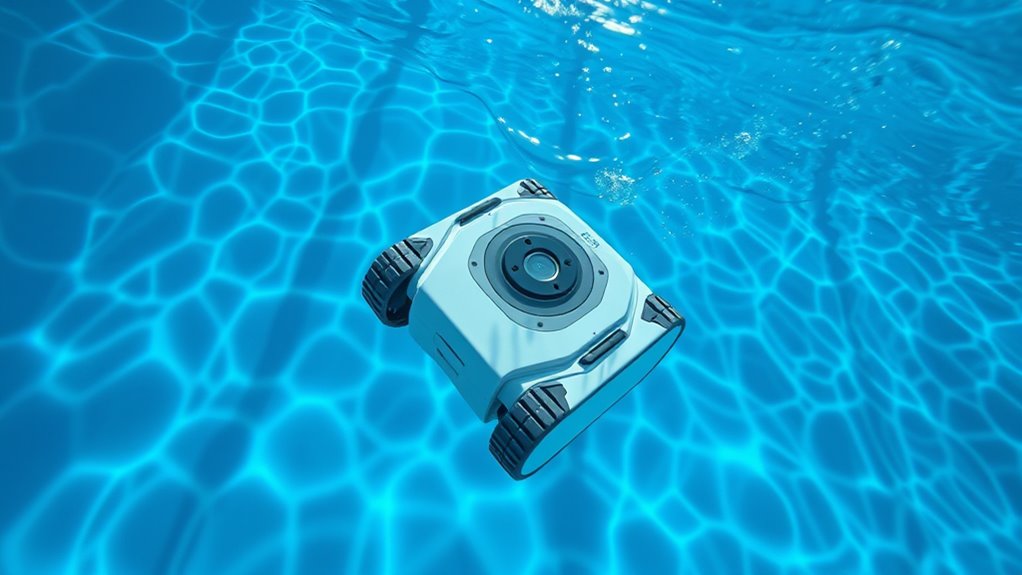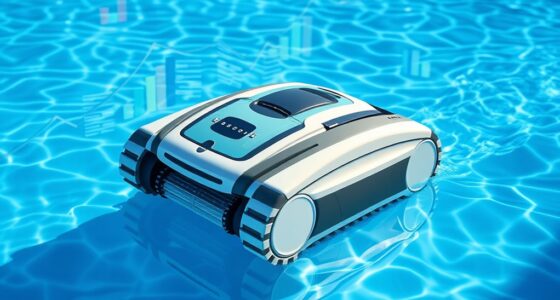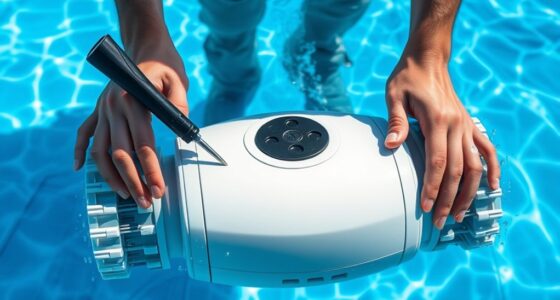Automatic pool cleaners excel at removing surface debris and keeping your pool floor clean, but they aren’t designed to eliminate algae or clear cloudy water entirely. They can help with surface algae build-up and debris but often struggle to penetrate deep or stubborn algae and cloudy conditions. To keep your pool crystal clear, you’ll need proper chemical treatments and regular maintenance. For more tips on optimizing your pool’s cleanliness, keep exploring how to get the best results.
Key Takeaways
- Automatic pool cleaners effectively remove surface debris but are less capable of eliminating stubborn or deep-seated algae.
- They improve water circulation, which aids in controlling algae and cloudiness when combined with proper chemical balance.
- Robotic cleaners struggle to clean algae embedded in walls, corners, or deep pool areas thoroughly.
- Regular chemical treatment and filtration are essential; cleaners alone cannot fully address algae or persistent cloudiness.
- For best results, use automatic cleaners alongside manual cleaning and chemical adjustments to maintain clear, algae-free water.
How Automatic Pool Cleaners Work and Their Cleaning Capabilities
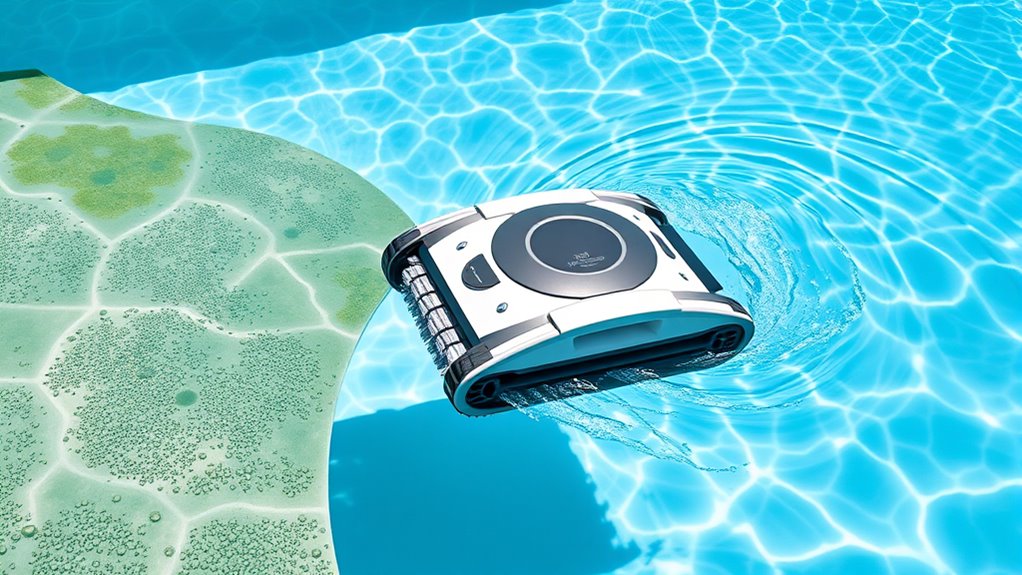
Automatic pool cleaners operate by moving across the pool surface and floor to remove dirt, debris, and algae without much manual effort. They help maintain pool safety by keeping the water clean and reducing the risk of bacteria buildup. Proper chemical balance is essential because it enhances the cleaner’s effectiveness and prevents algae growth. When the chemicals are balanced, debris is easier to pick up, and the cleaner can operate smoothly without getting stuck or missing spots. These devices use brushes, suction, or scrubbing mechanisms to ensure thorough cleaning. By automating this process, they save you time and effort, allowing you to enjoy a safe, healthy, and inviting swimming environment. Regular use of an automatic cleaner complements your efforts to keep the pool safe and well-maintained.
Effectiveness of Robotic Cleaners Against Algae Buildup
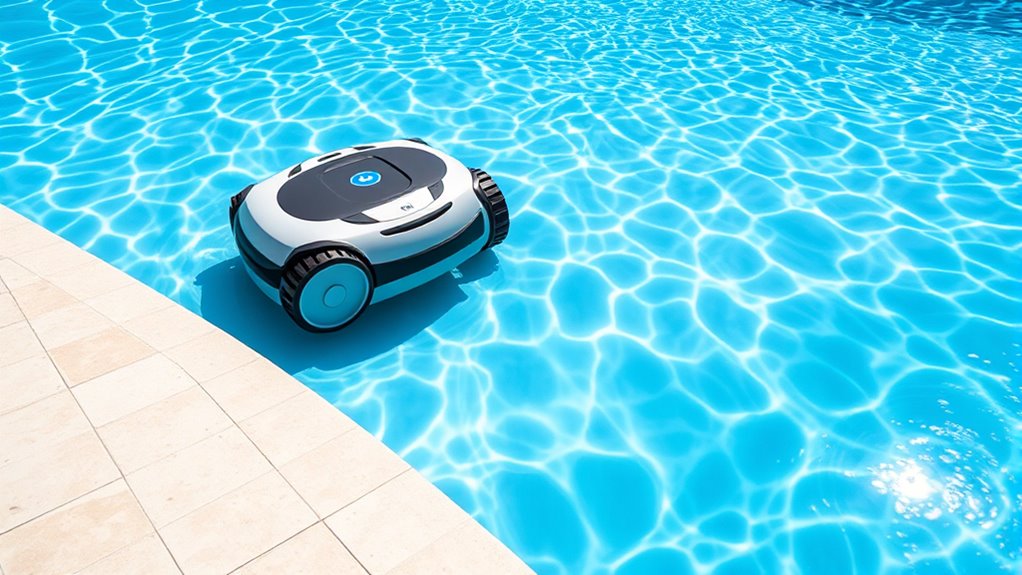
Robotic cleaners can be effective at removing surface algae and preventing its spread, especially with regular use. However, they may not fully eliminate stubborn algae in deeper layers or along the pool walls. Keep in mind, these cleaners are less efficient at controlling bacteria, which requires additional treatment methods. Incorporating regular maintenance and proper chemical balancing can further enhance pool clarity and hygiene. Additionally, understanding the types of algae present can help determine the most effective treatment approach. Using the appropriate filtration systems can also improve overall water quality and support algae prevention efforts. Employing advanced water testing techniques can aid in maintaining optimal chemical levels and preventing algae growth. Opting for high-quality Suprem fabric components in pool covers or filters can provide increased durability and performance in demanding conditions.
Algae Removal Capabilities
Are robotic pool cleaners truly effective at tackling stubborn algae buildup? While they excel at scrubbing surfaces and removing debris, their algae removal capabilities alone aren’t enough. For algae prevention, maintaining proper chemical balancing is essential. Robotic cleaners can help disturb algae spores and prevent extensive growth, but they don’t replace chemical treatments or filtration systems. To effectively combat algae, you need to regularly shock your pool and keep pH levels in check. A well-balanced chemical environment inhibits algae growth and supports the cleaner’s efforts. Additionally, understanding the importance of chemical balance can significantly enhance algae control. Implementing effective filtration systems can further improve your pool’s defenses against algae and keep the water clear. Recognizing warning signs of algae, such as slimy surfaces or discoloration, can help address issues early before they become unmanageable.
Limitations in Bacteria Control
While robotic pool cleaners excel at removing debris and scrubbing surfaces, they have notable limitations when it comes to controlling bacteria and algae buildup. These cleaners don’t address bacterial resistance, which can allow harmful bacteria to survive despite surface cleaning. They also have limited ability to manage chemical interactions, such as ensuring proper chlorine levels that prevent algae growth. Robotic cleaners cannot dispense or adjust disinfectants, meaning bacteria can persist in hidden corners or biofilms. This makes them insufficient for exhaustive bacteria control. To keep your pool safe and clear, you need to rely on proper chemical treatment alongside robotic cleaning. Without this combined approach, algae and bacteria can continue to thrive, undermining your efforts to maintain a healthy, sparkling pool. Additionally, bedroom decor elements like vintage furniture and rustic lighting can help create a relaxing environment that encourages proper pool maintenance routines.
Can Automatic Cleaners Clear Cloudy Water?
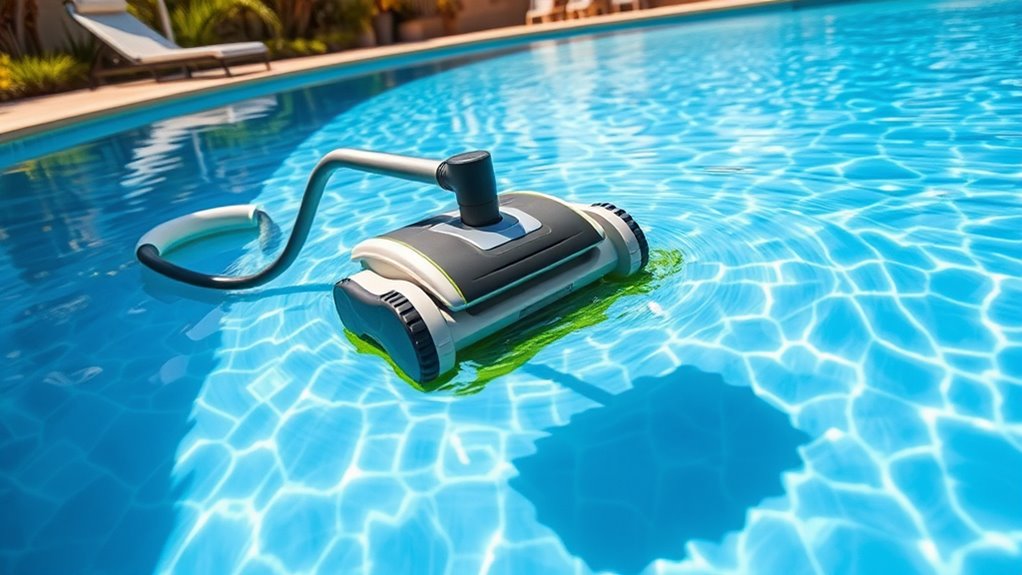
Can automatic pool cleaners effectively clear cloudy water? The answer depends on your pool’s water circulation and chemical balance. If your water isn’t circulating properly, debris and particles can settle, making the water appear cloudy. An automatic cleaner can help remove visible debris, but it won’t fix underlying issues like improper pool chemicals. Balancing chemicals such as chlorine and pH levels is essential to break down organic matter causing cloudiness. Good water circulation ensures chemicals distribute evenly, preventing stagnation and buildup. While robotic cleaners can improve water clarity by removing surface and bottom debris, they work best when paired with proper chemical treatment and circulation. Addressing these factors is key to achieving crystal-clear water, not just relying solely on the cleaner. Proper water chemistry and circulation are crucial for long-term clarity and health. Regular maintenance and understanding of pool chemistry can dramatically impact the effectiveness of your cleaning efforts. Implementing automatic cleaners as part of a comprehensive pool maintenance routine enhances overall water quality and clarity. For optimal results, it’s also important to monitor and adjust your filtration system regularly to prevent debris buildup and ensure efficient operation. Emphasizing the importance of consistent messaging about pool maintenance can lead to better long-term results.
Limitations of Robotic Pool Cleaners in Handling Algae
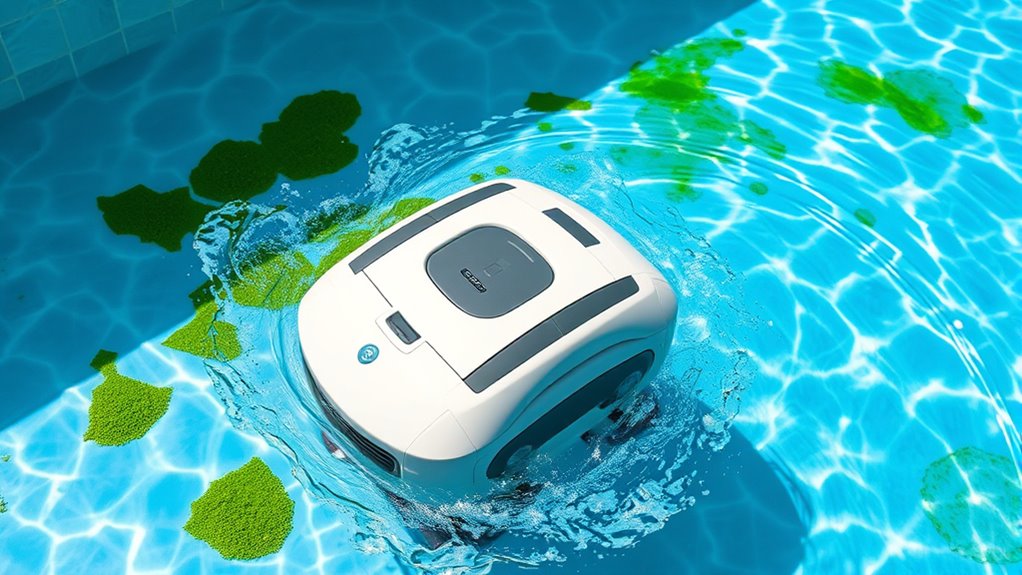
Robotic pool cleaners often struggle with algae because it can penetrate surface layers and hide in hard-to-reach spots. They also have trouble cleaning algae on the walls and deep areas of your pool effectively. As a result, algae buildup can persist, requiring additional manual intervention or chemical treatment.
Algae Penetration Challenges
Algae penetration poses a significant challenge for robotic pool cleaners, as their cleaning mechanisms often struggle to effectively remove stubborn organic growth. If you don’t focus on algae prevention and proper pool cover maintenance, algae can quickly take hold, infiltrating areas the robot can’t reach. This leaves you battling persistent algae patches, no matter how many times you run the cleaner.
Consider these emotional hurdles:
- Frustration from algae spreading despite your efforts.
- Anxiety about potential damage to your pool’s surfaces.
- Disappointment from ineffective cleaning results.
Robotic cleaners excel at surface cleaning but often miss deep algae roots. To combat this, regular maintenance and targeted chemical treatments are essential to keep algae from penetrating your pool’s defenses.
Surface Cleaning Limitations
While robotic pool cleaners are effective at removing surface debris, they often fall short when it comes to tackling stubborn algae spots. These cleaners typically lack the ability to scrub algae thoroughly, leaving some patches behind. Additionally, if your pool’s chemical balance isn’t maintained properly, algae can cling to surfaces despite cleaning efforts. Pushing the cleaner over rough or uneven surfaces may cause surface damage, further complicating algae removal. You might also notice that robotic cleaners don’t always reach tight corners or beneath steps, where algae can thrive. To effectively combat algae, you need to address chemical imbalances and manually scrub areas the robot overlooks. Relying solely on a robotic cleaner limits your ability to manage surface algae buildup all-encompassing.
Deep Pool Contamination
Have you noticed that deep pool contamination can persist even after surface cleaning? Robotic cleaners often miss algae lurking at the bottom, where poor pool chemical balance allows growth. This can lead to: 1. Algae spreading unnoticed, causing cloudy water and health risks. 2. Persistent stains that robotic cleaners can’t remove without manual techniques. 3. Increased frustration as algae reappears despite regular cleaning. Deep contamination highlights the limits of automatic pool cleaners, especially when you neglect proper chemical balance. Manual cleaning techniques become essential for scrubbing stubborn algae and adjusting chemicals to prevent future issues. Relying solely on robotic cleaners may leave your pool vulnerable to deep-seated algae that threaten water clarity and safety. To truly tackle deep contamination, you need a combination of effective chemical management and hands-on cleaning. Proper pool maintenance and regular monitoring are crucial for keeping your pool pristine and algae-free. Incorporating effective chemical balancing can significantly reduce algae growth and ensure your pool remains clear and healthy. Understanding the limitations of robotic cleaners can help you develop a comprehensive approach to pool care, preventing deep algae buildup and maintaining optimal water quality. Additionally, choosing the right automated cleaning technology can enhance your overall pool maintenance strategy. Recognizing the importance of chemical balance can help prevent algae from taking hold in the first place. Only then can you ensure your pool stays crystal clear and algae-free.
Tips for Enhancing the Performance of Automatic Pool Cleaners

To get the most out of your automatic pool cleaner, regular maintenance and strategic adjustments are essential. Start by keeping your pool’s chemistry balanced; proper pH and sanitizer levels prevent algae buildup and improve cleaning efficiency. Regularly check and clean your filter to ensure peak flow and debris removal—clogged filters reduce suction power and cleaning performance. Adjust the cleaner’s path or schedule to cover all pool areas evenly, avoiding missed spots. Clear obstructions and remove debris from skimmers and pump baskets to maintain consistent suction. Additionally, ensure your pool’s water level is correct, as low levels can impair the cleaner’s operation. Proper pool tuning and maintenance are crucial for optimal performance. By maintaining balanced pool chemistry and clean filters, you’ll help your automatic cleaner work more effectively, saving time and ensuring a sparkling, algae-free pool. Regular inspections of AI-driven diagnostics can also help identify potential issues early and keep your pool equipment functioning smoothly. To further enhance cleaning efficiency, consider using advanced cleaning algorithms that optimize the cleaner’s navigation and coverage.
When to Use Additional Algae Treatments and Clarifiers

Knowing when to add extra algae treatments and clarifiers is key to maintaining a clean and healthy pool. If your automatic pool cleaner isn’t removing algae effectively or the water remains cloudy despite regular cleaning, it’s time to act. Proper chemical balancing is essential for algae prevention and clarity.
You should consider additional treatments if:
- You notice persistent green or cloudy water even after running your cleaner.
- Algae begins to form despite regular sanitizing.
- The pool shows signs of algae bloom or debris accumulation that the cleaner can’t handle alone.
Adding algae treatments and clarifiers at these moments helps restore balance, prevent further growth, and keep your pool inviting. Recognizing these signs guarantees your automatic cleaner works efficiently and your pool stays crystal clear.
Best Practices for Maintaining a Crystal Clear Pool
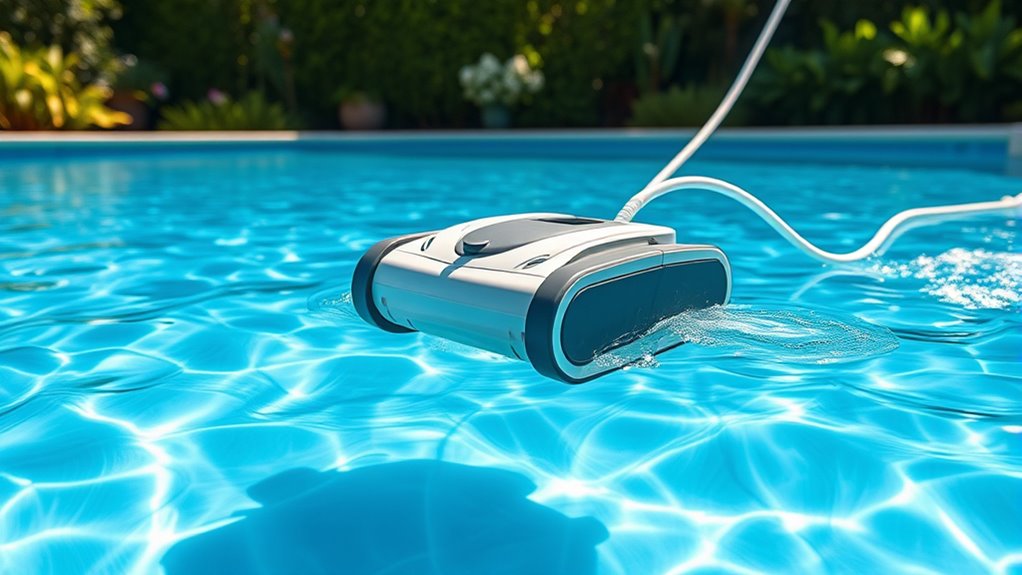
Maintaining a crystal clear pool requires consistent effort and proper techniques. Regularly test your water chemistry and adjust pool chemicals like pH, chlorine, and alkalinity to keep conditions balanced. Proper water circulation is essential; run your pump long enough each day to filter the entire volume effectively. This prevents stagnation and helps distribute chemicals evenly. Keep your pool’s filter clean and backwash or clean it as needed to ensure peak performance. Skim debris daily and brush the walls and floor regularly to prevent algae buildup. Maintaining proper water circulation combined with balanced pool chemicals minimizes cloudy water and algae growth. Consistency in these practices ensures your pool stays inviting, clean, and crystal clear, making your swimming experience enjoyable all season long.
Choosing the Right Cleaner for Algae and Cloudy Conditions

When you notice algae growth or cloudy water despite your regular maintenance, selecting the right cleaner becomes essential. A suitable automatic cleaner can help restore your pool’s clarity and ensure safety. Consider these options:
- Robotic cleaners with strong scrubbing power to tackle stubborn algae and debris, improving pool safety.
- Suction-side cleaners that cover large areas quickly, helping maintain proper chemical balance.
- Pressure-side cleaners designed for heavy algae loads, reducing the risk of cloudy water and algae spread.
Frequently Asked Questions
Can Robotic Cleaners Remove Algae From Pool Walls Effectively?
Robotic cleaners can effectively remove algae from pool walls, thanks to their robotic efficiency and advanced algae removal techniques. You should guarantee your robot has scrubbing brushes and powerful suction to tackle stubborn algae buildup. Regular use combined with proper chemical treatment enhances results. While robotic cleaners excel at surface cleaning, maintaining water chemistry is vital for thorough algae management, making your pool cleaner’s effectiveness even better.
Do Automatic Pool Cleaners Require Special Filters for Algae Removal?
Automatic pool cleaners don’t need special filters to remove algae, but filter maintenance is key. Regularly cleaning or replacing your filters helps prevent algae buildup and keeps your pool crystal clear. While some models have fine filters for better debris capture, algae prevention depends more on proper chemical balance and circulation. Using the right filtration and maintaining it guarantees your cleaner works efficiently and keeps algae at bay.
How Often Should I Run My Cleaner During Algae Outbreaks?
During algae outbreaks, you should run your automatic pool cleaner more frequently, ideally daily, to keep debris in check. Combine this with regular chemical treatment to kill algae and manual brushing to loosen stubborn patches. This approach guarantees your pool stays clearer and healthier. Remember, consistent cleaning and chemical balance are key to managing algae and preventing cloudiness effectively.
Are There Specific Models Better Suited for Cloudy Water Conditions?
When it comes to cloudy water, some automatic pool cleaners are better equipped than others. Think of it as finding the right tool for the job. Look for models with advanced filter types, like DE or cartridge filters, which trap finer particles. Regular cleaning schedules guarantee the best performance. These models actively target debris and algae, making your pool crystal clear without you having to lift a finger.
Can Automatic Cleaners Prevent Algae Growth or Only Clean Existing Buildup?
Automatic pool cleaners mainly focus on cleaning existing algae and debris, rather than preventing algae growth itself. To effectively prevent algae, you need to maintain proper chemical balancing and regular chlorination. While some advanced models may help keep your pool clean, algae prevention relies on your routine chemical treatments and water circulation. Using an automatic cleaner alongside proper chemical balance is your best approach to keeping your pool clear and algae-free.
Conclusion
While automatic pool cleaners are great for regular upkeep, they’re like a skilled gardener—they can’t tackle every weed alone. For algae and cloudy water, you’ll need to combine their use with proper chemical treatments and regular maintenance. Think of your pool as a delicate symphony; each component must work in harmony. By staying proactive and informed, you’ll keep your pool sparkling clear, just like a well-tuned melody that’s music to your eyes.
